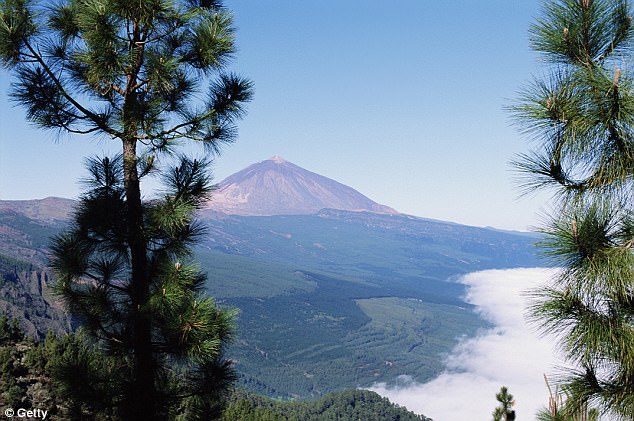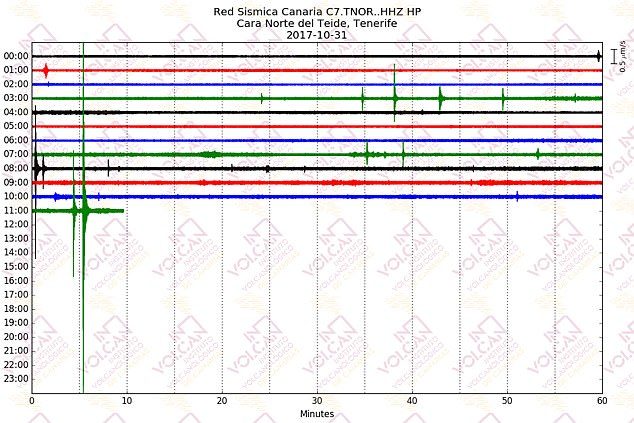
The tremors struck the popular tourist village of Vilaflor on the slopes of the 12,000ft volcano last week.
They were relatively minor quakes, however. The most power was a tremor of magnitude 1.4 striking at 11.05am local time (11:05 GMT, 06:05 GMT) on Tuesday morning.
Mount Teide's 3,718-metre summit is the highest point in Spain and a major tourist attraction with around three million tourists visiting every year.
The seismic swarm, recorded at an average depth of six to eight kilometres below sea level, took place over four days from 28 October to 31 October.
The Volcanological Institute of the Canary Islands (Involcan) have been trying to calm people.

'These types of swarms are common in active volcanoes', they wrote, explaining that it was caused by changes in the pressure in the hydro-thermal system.
Lucan Duria, a physicist and volcano monitoring expert at Involcan told MailOnline there are normally two or three earthquakes every day near Mount Teide, so there was 'nothing special' about recent activity.
The earthquakes in the past few days have been linked to hydrothermal systems connected to the volcano that produce fluids, water and steam.
'Most volcanoes have shallow hydrothermal systems and when there is an increase in the pressure, these fluids mean earthquakes happen more easily then they do in other places.
'Even a very small increase in pressure can cause earthquakes and remember these are very small earthquakes.
'For the volcano to erupt the magma needs to erupt to a shallow level, but there is no risk of this happening in Teide as it is far too low', he said.
According to Oregon State University, most earthquakes directly beneath a volcano are caused by the movement of magma.
The magma places pressure on the rocks until it cracks the rock.
Magma then moves into the crack and begins building pressure again. Every time the rock cracks it makes a small earthquake.
Teide last erupted in 1909 from the El Chinyero vent on the Santiago Ridge.
Experts from the National Geographic Institute (IGN) said residents had not felt recent movements.
Yesterday an expert warned that Tenerife is not the only island at risk of eruption at the moment and Iceland's biggest volcano could also be brewing.
Páll Einarsson, a geophysicist at the University of Iceland, says this shows that pressure in the volcanoes magma chamber is increasing.
He warns that the tremors mean Bardarbunga is 'clearly preparing for its next eruption' in the next few years which could create an ash cloud that will cause travel chaos.
The warning follows the 2010's explosive eruption of Icelandic volcano Eyjafjallajökull, which threw thousands of tonnes of mineral ash into the air.
Most of this was fine particles that created an ash cloud.
This caused travel chaos causing more than 10 million air passengers to be stranded as a result of its ash cloud and cost the European economy an estimated £4 billion ($4.9 billion).
A similar scenario could take place if Bardarbunga were to erupt.
Bardarbunga is one of the most active of Iceland's 130 volcanoes.
The Canary holiday island of La Palma experienced more than 300 mini-earthquakes last month, scientists report.
A majority of the tremors were so small they could not be located by scientists, let alone felt by any residents on La Palma.
The latest mini-quakes followed the 40 tremors that were recorded in the weeks previously, taking the total to 352 in just ten days.



Comment: This report should also viewed in the wider context of the increased seismic activity noted elsewhere around this archipelago over the last 4 weeks, as illustrated by the following reports:-
Canary Island volcanologists monitoring eruption, tsunami risks from Cumbre Vieja after recent wave of tremors
La Palma volcano in the Canary Islands hit by hundreds of earthquakes in 15 hours
Scientists on alert as underwater volcano Tagoro in the Canary Islands bursts into life
40 earthquake tremors in 48 hours hit La Palma, Canary Islands